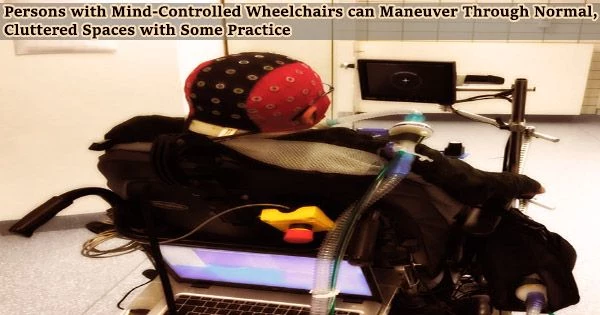A mind-controlled wheelchair that translates users’ thoughts into mechanical controls can assist a disabled person in regaining their mobility. Researchers show that with extensive practice, tetraplegic users can control mind-controlled wheelchairs in a messy, natural environment on November 18, 2022, in the journal iScience.
“We show that mutual learning of both the user and the brain-machine interface algorithm are both important for users to successfully operate such wheelchairs,” says José del R. Millán, the study’s corresponding author at The University of Texas at Austin. “Our research highlights a potential pathway for improved clinical translation of non-invasive brain-machine interface technology.”
Millán and his colleagues recruited three tetraplegic people for the longitudinal study. Each of the participants underwent training sessions three times per week for 2 to 5 months. The subjects donned a skullcap that used electroencephalography (EEG) to monitor their brain activity, which was then translated into mechanical wheelchair controls by a brain-machine interface device.
The direction of the wheelchair was to be controlled by the participants by mentally manipulating various body parts. To turn left, they needed to move both hands, and to turn right, they needed to move both feet.
Three participants in the first training session all achieved accuracy levels between 43% and 55% when the device’s responses matched users’ thoughts. The brain-machine interface device team noticed a noticeable improvement in participant 1’s accuracy during the course of training, and by the end of his training, he had attained an accuracy of over 95%.
Our research highlights a potential pathway for improved clinical translation of non-invasive brain-machine interface technology.
José del R. Millán
Before the team upgraded his gadget with a new algorithm, the team noticed a rise in accuracy in participant 3 to 98% midway through his training.
The improvement seen in participants 1 and 3 is correlated with improvement in feature discriminancy, which is the algorithm’s ability to discriminate the brain activity pattern encoded for “go left” thoughts from that for “go right.”
The team discovered that the improved feature discriminancy is due to both participant learning and machine learning of the device. Participants 1 and 3’s EEGs clearly demonstrated changes in brainwave patterns as they became more accurate at mind-controlling the device.
“We see from the EEG results that the subject has consolidated a skill of modulating different parts of their brains to generate a pattern for ‘go left’ and a different pattern for ‘go right,’” Millán says. “We believe there is a cortical reorganization that happened as a result of the participants’ learning process.”
Throughout the training, participant 2’s brain activity patterns did not differ significantly from those of participants 1 and 3 in any way. After the first few sessions, his accuracy only marginally improved; it then stayed stable for the remainder of the training period.
“It suggests machine learning alone is insufficient for successfully maneuvering such a mind-controlled device,” Millán says
All participants were required to maneuver their wheelchairs across a crowded hospital room after the training. Obstacles such a room divider and hospital beds, which are arranged to mimic the real-world setting, have to be avoided. Both participants 1 and 3 finished the task while participant 2 failed to complete it.
“It seems that for someone to acquire good brain-machine interface control that allows them to perform relatively complex daily activity like driving the wheelchair in a natural environment, it requires some neuroplastic reorganization in our cortex,” Millán says.
The study also emphasized the role of long-term training in users.
“Although participant 1 performed exceptionally at the end, he struggled in the first few training sessions as well,” Millán says. The longitudinal study is one of the first to evaluate the clinical translation of non-invasive brain-machine interface technology in tetraplegic people.
The team’s next goal is to determine why participant 2 didn’t benefit from the lesson. They want to understand the disparities among all participants’ brain signals in order to determine future therapies that can help those who have trouble learning.
















